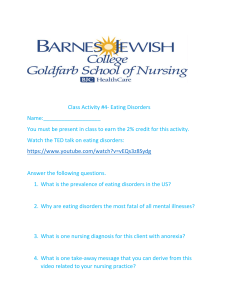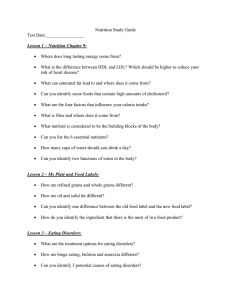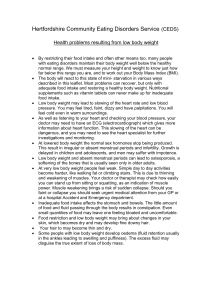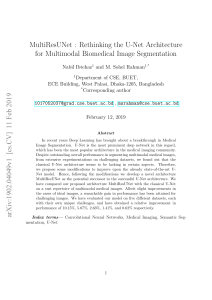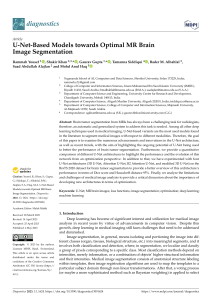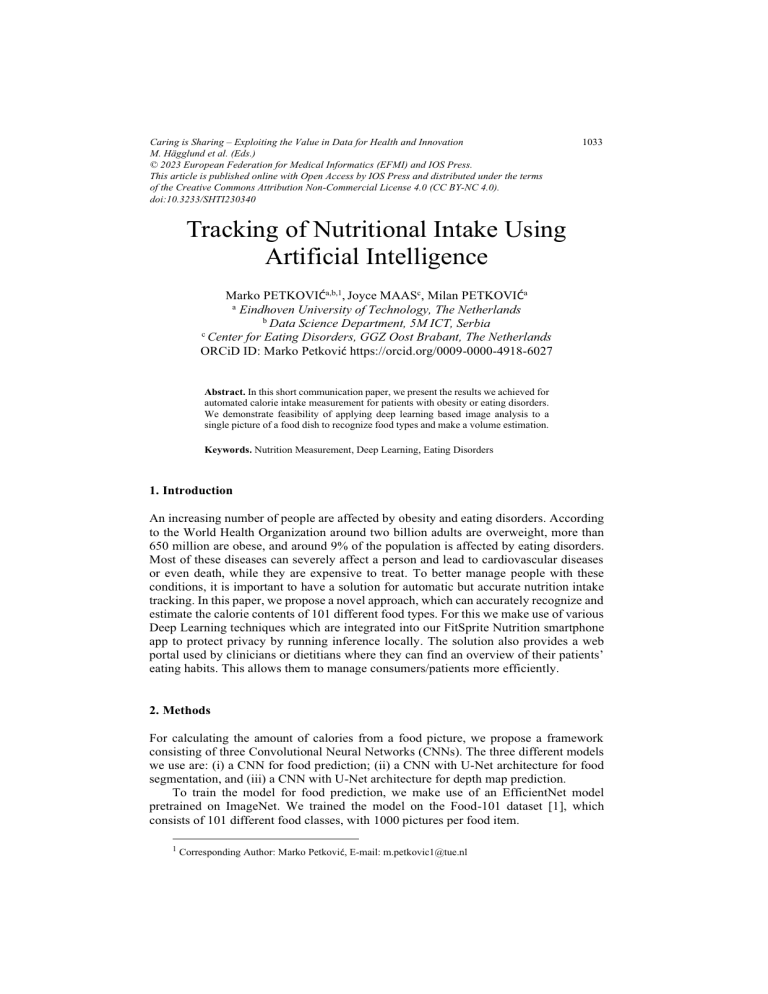
Caring is Sharing – Exploiting the Value in Data for Health and Innovation M. Hägglund et al. (Eds.) © 2023 European Federation for Medical Informatics (EFMI) and IOS Press. This article is published online with Open Access by IOS Press and distributed under the terms of the Creative Commons Attribution Non-Commercial License 4.0 (CC BY-NC 4.0). doi:10.3233/SHTI230340 1033 Tracking of Nutritional Intake Using Artificial Intelligence Marko PETKOVIĆa,b,1, Joyce MAASc, Milan PETKOVIĆa a Eindhoven University of Technology, The Netherlands b Data Science Department, 5M ICT, Serbia c Center for Eating Disorders, GGZ Oost Brabant, The Netherlands ORCiD ID: Marko Petković https://orcid.org/0009-0000-4918-6027 Abstract. In this short communication paper, we present the results we achieved for automated calorie intake measurement for patients with obesity or eating disorders. We demonstrate feasibility of applying deep learning based image analysis to a single picture of a food dish to recognize food types and make a volume estimation. Keywords. Nutrition Measurement, Deep Learning, Eating Disorders 1. Introduction An increasing number of people are affected by obesity and eating disorders. According to the World Health Organization around two billion adults are overweight, more than 650 million are obese, and around 9% of the population is affected by eating disorders. Most of these diseases can severely affect a person and lead to cardiovascular diseases or even death, while they are expensive to treat. To better manage people with these conditions, it is important to have a solution for automatic but accurate nutrition intake tracking. In this paper, we propose a novel approach, which can accurately recognize and estimate the calorie contents of 101 different food types. For this we make use of various Deep Learning techniques which are integrated into our FitSprite Nutrition smartphone app to protect privacy by running inference locally. The solution also provides a web portal used by clinicians or dietitians where they can find an overview of their patients’ eating habits. This allows them to manage consumers/patients more efficiently. 2. Methods For calculating the amount of calories from a food picture, we propose a framework consisting of three Convolutional Neural Networks (CNNs). The three different models we use are: (i) a CNN for food prediction; (ii) a CNN with U-Net architecture for food segmentation, and (iii) a CNN with U-Net architecture for depth map prediction. To train the model for food prediction, we make use of an EfficientNet model pretrained on ImageNet. We trained the model on the Food-101 dataset [1], which consists of 101 different food classes, with 1000 pictures per food item. 1 Corresponding Author: Marko Petković, E-mail: m.petkovic1@tue.nl M. Petković et al. / Tracking of Nutritional Intake Using Artificial Intelligence 1034 For the task of food segmentation, we made use of the UEC-FoodPixComplete dataset [2], which contains 10000 food pictures with their pixel-wise segmentation masks for each individual food item in the picture (a different color mask for fries, steak etc.). We trained a U-Net, using the food prediction model as encoder. To record the performance of the model, we used the Intersection over Union metric. For depth estimation, we trained a U-Net using self-supervised monocular depth prediction. This model was trained on the EPIC-KITCHENS dataset [3], which contains 100 hours of recordings of food preparation. 3. Results For the food prediction task, we achieved a top-1 accuracy of 0.81 and a top-5 accuracy of 0.94. The image segmentation network achieved an Intersection over Union of 0.91, while combined with the depth estimation network it achieved a mean absolute percentage error of 11.7% in predicting food volume. 4. Discussion Overall, we see that it is possible to make fairly accurate calorie intake estimations using our proposed models. We also found that by combining the food prediction and segmentation tasks, we were able to achieve a better performance for food segmentation. The performance of our food prediction network is better than current methods which are able to run locally on smartphones [4]. For the image segmentation task, we obtained solid performance by achieving a higher Intersection over Union than the current best food segmentation network [5]. 5. Conclusion In this paper, we have shown that automated tracking of nutrition is feasible. We finalized two pilots with users of a fitness club and patients with binge eating disorder and their clinicians in the Center for Eating Disorders in Helmond in the Netherlands. The pilots demonstrated the benefits for both, users/patients for the automation in the creation of patient dairies, and coaches/clinicians for more efficient patient management. References [1] [2] [3] [4] [5] Bossard L, Guillaumin M, Van Gool L. Food-101–mining discriminative components with random forests. In Computer Vision–ECCV 2014 Proceedings, Part VI (pp. 446-461). Springer. Okamoto K, Yanai K. UEC-FoodPIX Complete: A large-scale food image segmentation dataset. In Pattern Recognition ICPR. Proceedings, Part V 2021 (pp. 647-659). Springer International Publishing. Damen D, Doughty et al. Rescaling egocentric vision: Collection, pipeline and challenges for epickitchens-100. International Journal of Computer Vision. 2022 Jan 1:1-23. Lo FP, Sun Y, Qiu J, Lo B. Image-based food classification and volume estimation for dietary assessment: A review. IEEE journal of biomedical and health informatics. 2020 Apr 30;24(7):1926-39. Ando Y, Ege T, Cho J, Yanai K. Depthcaloriecam: A mobile application for volume-based foodcalorie estimation using depth cameras. In MADiMa (pp. 76-81) https://doi.org/10.1145/3347448.3357172.

